The Bridge Blog
A dialog about our new bridge and these web pages
Overview. As a pointy-headed
university professor, my weekend project of bridge photography and
building these web pages generated many questions and introduced me
to just-in-time learning. I enjoy chasing my curiosity and
want to identify ways to encourage younger learners to also enjoy curiosity
chasing and learning.
Learning usually requires repetition while forgetting occurs when
I infrequently use information. Many young learners do not understand
the importance of repetition. Weekly visits to the bridge provided
the repetition necessary to detect changes in the bridge and
consequently generated
many questions and opportunities for learning. Over the course of the
bridge project, I had access to few experts for answering questions.
Rather than a liability, this became an asset and pushed me to improve
my search skills with Google. Soon, I found that answers
to questions encountered during my weekly photo shoots were often
only a Google-search away -
(see
Restoring the Joy in Learning). Consequently Google + Internet became
dependable extensions of my memory.
The bridge story is a work in progress and is evolving from a simple
collections of photographs to an experiment with Internet-centric
just-in-time learning.
Insights I gain from you
will find their way into the learning centers of MUSC.
Palmetto Bridge Constructors, a joint venture between
Tidewater
Skanska and
Flatiron Constructors, as well as
High Steel Structures,
Freyssinet, the
SCDOT and the
Federal Highway Commission Office
of Bridge Technology guided much of my learning.
I also learn from many of you and from Google-linked resources. More
important is the e-mail encouragement I receive from many of you.
Mon, 28 Mar 2005
March 28, 2005: This past weekend was full of surprises.
First the
Charleston Post and Courier (specifically Jim Parker and his team)
ran a wonderful piece about me, the bridge / spider web pages
and issues of
learning, forgetting and the Internet that are near and dear to my heart.
In addition, I received more than my usual weekend share of email about
the bridge web pages. As many of you know, I love learning and enabling
others to learn. Among the weekend emails, Lewis Hudgins of Athens Georgia
related a delightful story about the early days of the project.
"I lived in Charleston for several years. I was Joe Riley's Executive Assistant.
I didn't think the nuances of the construction could possibly interest me as
much as the prolonged political intrigue which, happily, resulted in an
agreement to get the new Cooper River Bridge built. I was wrong. Your pictures
and narratives have been wonderful. It made all of us feel we were up there
with the crews. Also, it makes us want to know more about them and what
happens to them now. And, the awesome, technical aspect of the work was made
easier to understand because of you. (Who knew about the wax?)"
What we have all created with this web site, I believe, is a new sense of
community and being part of something that is remote from many of us.
As many of you know, many engineers and lay people have provided me with
particular insights and questions. PBC, SCDOT, Freyssinet, High Steel
Structures and the FHWA Bridge Division, have opened many
doors that gave me an insider look at things I never imagined (like injecting
wax into the cable anchors). Together we have built a learning site where
we are all able to contribute in many different ways. This is my time to
thank all of you!!!
posted at: 13:57 | path: | permanent link to this entry
Sun, 20 Mar 2005
March 20, 2005 Another attempt in improving the usability of these web pages
Each week I receive email from a number of you requesting some new insights
(for example, tracking the progress of the approaches or tracking the
unbuilding of the west tower crane). As I put these stories together and
increase the weekly set of routine photos, I wonder how anyone but me can
find anything among these pages.
Over the past year and a half, the organization
has progressed from 1 long linear web page to a group of pages to groupings
of pages. I have created an archive page with links to everything. But
again, unless you know what is in the archived pages, it might take several
attempts to locate what you are looking for. Last week, Jason Osborne
of Clemson, made a wonderful suggestion - why not put a last updated time
stamp on the menu bar and in the archive. I am feeling a bit guilty that
I did not think of this a long time ago. So now we have time stamps
indicating the last time I updated a story.
But today I thought about Google. Why not include a Google search box in
the header of each story and limit the Google search to my web site. Google
has a simple way to constrain search results by including the
clause site:ravenelbridge.net in the search expression. So I set up
a Google search box with this embedded in the search expression. Let me know
if this helps locating things.
posted at: 10:00 | path: | permanent link to this entry
Fri, 11 Mar 2005
March 11, 2005 Closing the Gap and Our Website Community
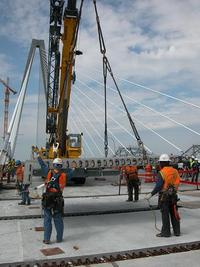 As many of you know, these bridge photo essays started as a simple way
for my grandchildren to watch the growing of the new Cooper River Bridge.
Sometime in the early spring of 2004, Bill Mankin of High Steel Structures,
sent me email with some comments about the web site. High Steel
fabricated all the edge and floor girders for the main span.
Bill's email and our subsequent exchanges changed
the web site from a Read Only web page to an interactive
Read Write web site that reflected information from our web
page community. Bill helped me understand some of the issues associated with
erecting the steel girders and later invited me to visit their facility
in Lancaster Pa.
As many of you know, these bridge photo essays started as a simple way
for my grandchildren to watch the growing of the new Cooper River Bridge.
Sometime in the early spring of 2004, Bill Mankin of High Steel Structures,
sent me email with some comments about the web site. High Steel
fabricated all the edge and floor girders for the main span.
Bill's email and our subsequent exchanges changed
the web site from a Read Only web page to an interactive
Read Write web site that reflected information from our web
page community. Bill helped me understand some of the issues associated with
erecting the steel girders and later invited me to visit their facility
in Lancaster Pa.
Many engineers and many more armchair engineers have joined our
conversation. When I encountered puzzles, many were quick to respond
with answers. For example Joe Krolak, an hydraulic engineer with
the Federal Highway Administration, Bridge Divistion, helped me
understand how one stabilizes barges that support cranes while
erecting girders while Boyd Gregg,
a civil engineer with Black & Veatch in
Alpharetta, Ga helped me understand the concept of tensioning - specifically
when I encountered PBC tensioning the lateral tendons that stabilized the
central segment of the east and west pylons. So I copied and pasted
Boyd's explanation into the details
web page. When I really got into engineering trouble, David Wertz with
SCDOT and Marvin Tallent with PBC helped me understand what was happening.
More recently, Peo Halvarsson provided opportunities to explore different
aspects of building the main deck and Oliver Forget with Freyssinet
helped me understand erecting cable stay pipes and pulling strands of
cable. I had a chance to see many things that simply increased my
curiosity. During these times, I met Wilbur Poole, an iron worker who
also manages the hydraulic systems used to position the deck. All these
folks were my teachers and I transferred what I learned to these
pages.
But many many people simply sent email to encourage me to continue. These
are the people that energized me to continue my weekly visits to the
SC Aquarium to take my "core data". Then Tina Cotter got into the picture.
Her husband, Philip, an iron worker, named one of the deck erection
cranes "Last Dinosaur Standing", the kind of humor that really turns me
on. When Tina told me the crane story, I could not resist adding some humor
to the placement of the last concrete floor panel - was Philip signaling
the crane operator, or was Philip secretly waving to Tina? Look at the
photo above and you be the judge.
What I am trying to say is that this web site is a community project - not
just Frank Starmer taking photos for his grandkids. The stories and
photos reflect significant influences from two of my kids -
Michael told me a long time
ago that my photos were chaos. "Never take a photo unless you are prepared
to tell a story". Not only good advice, but great advice. Josh then
introduced me to the humor side of photo essays with his dialog associated
with photos of my work in south India
(2001).
Gene Stead, chairman of Medicine at Duke,
was my first boss and taught me
the joy of learning. Gene asked lots of questions - not because he was
testing people, but because he was curious. Gene helped me to understand
that being curious was OK - not something that should be suppressed as
one becomes a teenager. My dad was also very curious and shared with me
that he never met someone from whom he could not learn something.
The Internet and Google level the playing field for all of us
curiosity chasers. And these web pages are really an experiment in what
I call Internet-centric learning. The days of teachers and
students are nearing an end and a new Internet-centric learning
paradigm is evolving. As with Gene - we are all learners in this world -
traditional teachers are more like senior learners while traditional
students are simply junior learners.
So these web pages are all about learning, my curiosity and
your encouragement. What started as a simple set of photos has evolved to
what we have now - a sort-of read write web site where many of you
contribute to my understanding aspects of building the new Cooper River Bridge.
I am grateful for your help, for your curiosity and for your encouragement.
posted at: 10:11 | path: | permanent link to this entry
Thu, 10 Mar 2005
March 10, 2005 Unseen tal
I suppose that some of you will think I've completely flipped out. Thinking
about where to go with the web pages and the images that I have acquired over
the past 20 months has led me down many paths. One suggestion by a friend
is to take a group of photos and make an art show. Knowing very little about
formal art (except what I learn from Josh and Bibi), Ellen played the idea of
our friend Debra Bieber, now in Dhaka Bangladesh. We met Debra and her
husband, Glen, while I was a visiting professor of Biomedical Engineering at
the Indian Institute of Technology, Madras (now Chennai). We were there from
1993 - 1994 and had the cultural experience of our life. During this time,
I was successful in managing my lab at Duke via the Internet, one of my
early experiences with Internet-centric life.
Anyway, I was considering three segments of an exhibit: time sequence of
the bridge growth, people and processes. As many of you know, I enjoy
learning from anyone and the bridge has provided many opportunities to learn
something of bridge technology. So Debra suggests the title "Unseen tal". I
am thinking, Deb has surely flipped out. Then Debra goes on to remind me
that tal is the rhythmic basis of classical (Carnatic (south) and
Hindustani (north) ) Indian music. I remembered going to my first classical
music performance at IIT (in the OAT). It was my first encounter with
classical Indian music and not at all what I expected. After the first few
numbers, I was ready to leave since it was completely not understandable.
There was a singer, drummer (tabla), violinist and veena and just as I was
about to give up, I suddenly realized that there was a rhythm (from the tabla
and veena) and a violin echo of what the singer was singing. And the singing
was not what I thought of as western singing but rather the singer was playing
his voice. All was suddenly understandable and enjoyable when I escaped from
my western paradigm of singing words and harmony and
saw that the singer was playing his instrument just as the violinist was
echoing the improvised composition with his instrument.
Tal (see the references below) is all about rhythm and Debra saw in my
photos a rhythm that is unseen by those viewing the bridge from afar. So
she composed the word, Unseen tal. I thought this was brilliant and felt
that Deb had caught the driving force of my bridge curiosity and my
passion for capturing the rhythm of the building of the bridge. So I am
thinking and playing with some ideas for a presentation.
posted at: 08:01 | path:
|
permanent link to this entry
Wed, 09 Mar 2005
March 9, 2005: Making ends meet (my wife wishes she could use hydraulic jacks and fork lifts to deal with family budget issues).
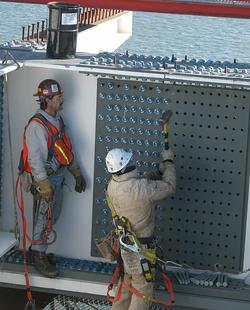 Closing the last gap (maybe last gasp?). Yesterday PBC and their iron
workers closed the final gap linking the west and east decks. Peo and his team
coaxed the two platforms into perfect alignment so that the splice plate could
be pinned and bolted. Shown here is driving the first drift pin into the
vertical splice plate linking the center edge girder with the south 216
edge girder.
Closing the last gap (maybe last gasp?). Yesterday PBC and their iron
workers closed the final gap linking the west and east decks. Peo and his team
coaxed the two platforms into perfect alignment so that the splice plate could
be pinned and bolted. Shown here is driving the first drift pin into the
vertical splice plate linking the center edge girder with the south 216
edge girder.
It was windy - really very windy. I discovered that the virtue of an
8 lane wide roadway is that when the wind blows your glasses - it takes a long
time to cover the width of the road and disappear. Fortunately I quickly
retrieved them. But in spite of the wind, the work continued.
I soon discovered some of the tricks these guys use to encourage the two decks
to behave and align themselves. Two major tools:
- Altering the horizontal alignment with hydraulic jacks (located at the
pylon).
- Altering the vertical alignment with counterweights. In this case,
the counterweights were mobile - consisting of fork lifts that moved toward
or away from the gap, with or without counterweights.
I would not have
thought changing the alignment a few inches would be so involved - and yet
relatively straight forward. It was a joy to watch this team do their magic!.
Today they are completing bolting up the vertical splice plates and horizontal
splice plates.
posted at: 10:00 | path:
|
permanent link to this entry
Sat, 05 Mar 2005
March 5, 2005: A visit from my dad
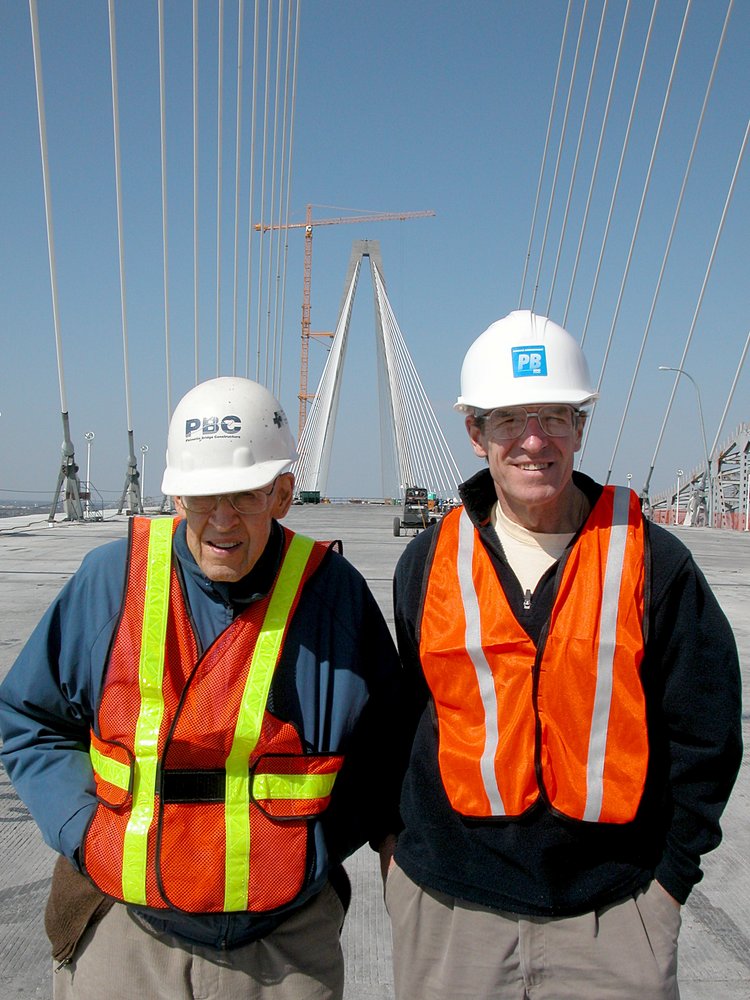 My dad transferred many gifts to me. But perhaps the greatest gift was that of
endless curiosity. When I was a kid - we used to travel to different
construction sites where he was installing elevators. Sometimes on the
weekends, we would visit a sick elevator and repair it. Sometimes we
simply walked from our home in Greensboro to the railroad switch house. We
would sit for hours watching the trains pass. We would count the cars.
Sometimes, we would enter the switch house and if we were good and very very
lucky we got to throw swiches which changed the communication between
parallel tracks. All the time, he displayed not only curiosity but an
enquiring mind.
My dad transferred many gifts to me. But perhaps the greatest gift was that of
endless curiosity. When I was a kid - we used to travel to different
construction sites where he was installing elevators. Sometimes on the
weekends, we would visit a sick elevator and repair it. Sometimes we
simply walked from our home in Greensboro to the railroad switch house. We
would sit for hours watching the trains pass. We would count the cars.
Sometimes, we would enter the switch house and if we were good and very very
lucky we got to throw swiches which changed the communication between
parallel tracks. All the time, he displayed not only curiosity but an
enquiring mind.
Yesterday my brother, Jack, phoned from Burlington, N.C. He had just driven to
my dad's place from Pennsylvania and announced, "can we visit"? Of course,
and so about 7pm last night they appeared. My dad is 88 and still just
as curious as ever. I knew of his love of construction and thought of the
possibility to drive to various places and view the new Cooper River Bridge.
The perfect opportunity for an unplan-plan.
Every time I said "Cooper River Bridge" he told a story about elevators
he installed at Santee Cooper - probably 50 years ago (I don't really know).
Anyway, this morning, we started our tour. We saw the bridge from many
perspectives. All the time he was telling
stories and looking and asking questions: a 16 year old curiosity hard
at work.
posted at: 12:15 | path: | permanent link to this entry
Tue, 01 Mar 2005
March 1, 2005: A Dinosaur story
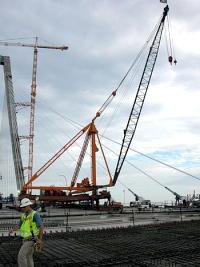 During the growth of the deck, there were 4 cranes, one located at each
end of each deck. Philip Cotter named one of them
"Last Dinosaur Standing" and I have a few
photos of this animal. I was told that each crane was an antique - over
100 years old. I've not been able to confirm this, but perhaps it is correct.
If so, then these cranes have seen many projects and I can imagine the
stories they have to tell. I have assembled a few photos
of
the Last Dinosaur Standing and placed them near the end of the close-up
page. Perhaps someone knows more about these creatures? If yes - don't keep
it a secret.
During the growth of the deck, there were 4 cranes, one located at each
end of each deck. Philip Cotter named one of them
"Last Dinosaur Standing" and I have a few
photos of this animal. I was told that each crane was an antique - over
100 years old. I've not been able to confirm this, but perhaps it is correct.
If so, then these cranes have seen many projects and I can imagine the
stories they have to tell. I have assembled a few photos
of
the Last Dinosaur Standing and placed them near the end of the close-up
page. Perhaps someone knows more about these creatures? If yes - don't keep
it a secret.
Many of you have discovered this page - an exploration of using a blog
(webLog) to express some of the content of these pages. I discovered
blogs from my IT Lab brain trust - a group of the greatest and friendliest
guys at MUSC. I was reluctant to engage this new tool - but as the bridge
web site spun out of control, some sort of organization was necessary. This
blog is a test of whether I can maintain some sort of links with photos that
are posted to different sections of the site and maintain a 1-way dialog with
all of you.
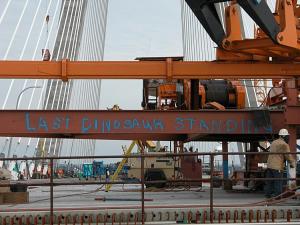 If you have not encountered blogs - it is the tool that is transforming web
resources from read-only to read-write. Blog tools permit individuals to
post thoughts and observations to the web without the geek-skills necessary
to manage a web site. This morning I ran across an article that
addesses
Blogs in education.
The thoughts parallel my thoughts about
Internet-centric learning
(see also
Restoring the joy of learning ) and the evolution of the bridge web
site - as a learning tool. I suggest you check it out and share your
impressions with me and your friends.
If you have not encountered blogs - it is the tool that is transforming web
resources from read-only to read-write. Blog tools permit individuals to
post thoughts and observations to the web without the geek-skills necessary
to manage a web site. This morning I ran across an article that
addesses
Blogs in education.
The thoughts parallel my thoughts about
Internet-centric learning
(see also
Restoring the joy of learning ) and the evolution of the bridge web
site - as a learning tool. I suggest you check it out and share your
impressions with me and your friends.
posted at: 09:55 | path: | permanent link to this entry